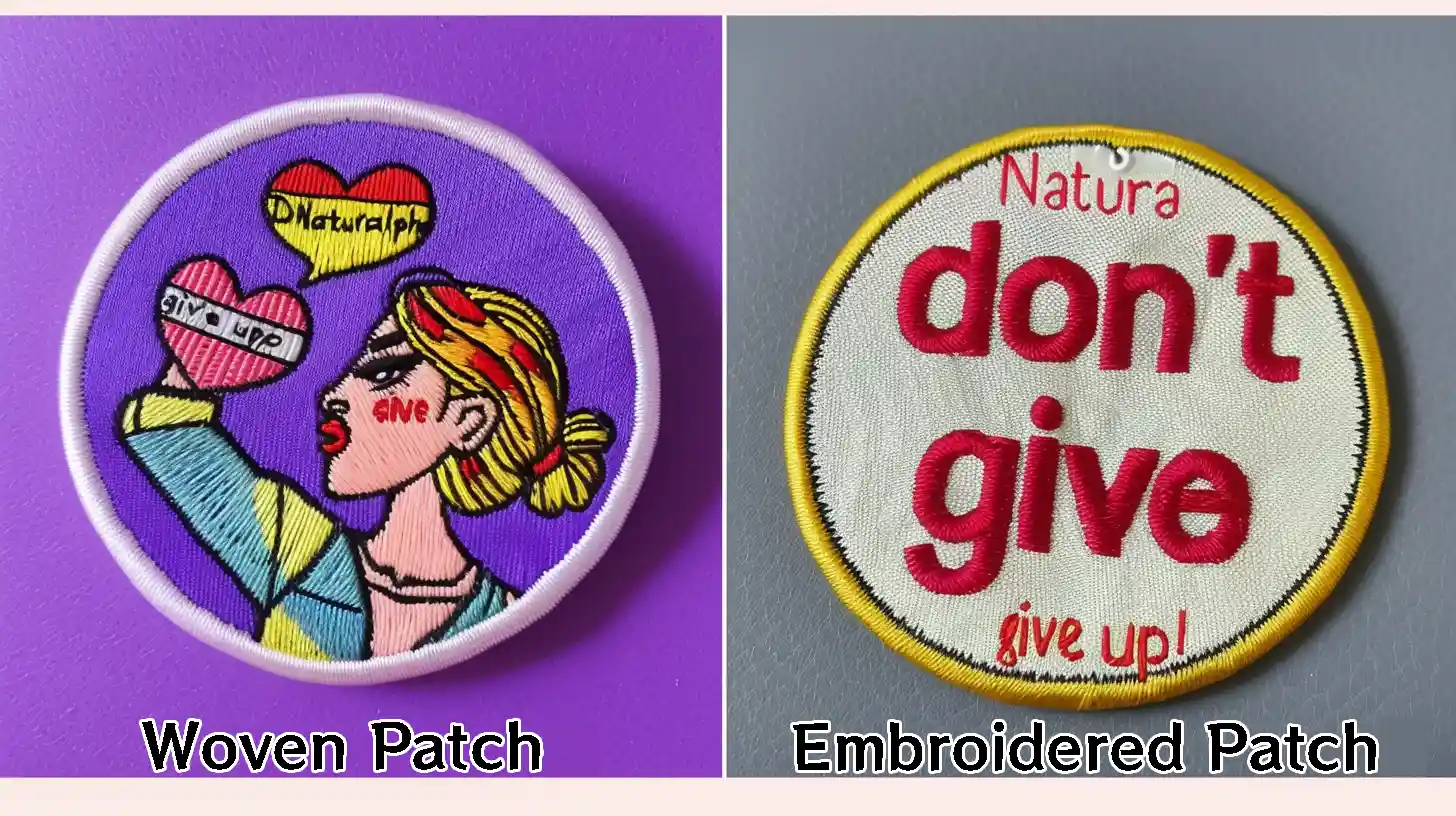Are you looking to add a touch of style and personalization to your clothing or accessories? Look no further than woven and embroidered patches! These versatile accessories are not only a fun way to showcase your personality, but also a great way to make a statement.
In this article, we’ll explore the differences between woven and embroidered patches, from their unique textures to their durability. Whether you prefer the intricate detailing of embroidered patches or the sleek finish of woven patches, there is something for everyone. Get ready to elevate your style game with these customizable and trendy patches.
Key Takeaways
- Woven patches capture fine details with smooth, flat finishes, ideal for intricate designs.
- Embroidered patches offer a textured, raised surface, perfect for a vintage or rugged look.
- Woven patches are more cost-effective and have faster production times than embroidered patches.
- Embroidered patches use thicker threads, providing a distinct tactile feel, but are less flexible.
- Woven patches are versatile for detailed logos and patterns, while embroidered patches add depth and dimension to designs.
What is a Woven Patch?

Creating woven patches involves weaving threads into fabric to form intricate, detailed designs. The weaving process employs thinner threads, which makes a custom woven patch ideal for capturing fine details and clean lines.
Pros of Woven Patches
Woven patches offer several advantages, including capturing intricate details and providing a clean, flat appearance. They’re ideal for detailed artwork, making them popular for logos and complex patterns.
Additionally, they’re cost-effective, especially when produced in large quantities, ensuring you get high quality without breaking the bank.
Another plus is their versatility. You can place them on various items without worrying about losing detail, even in smaller sizes.
Cons of Woven Patches
Despite their advantages, woven patches do have some drawbacks that you should consider.
The use of thinner threads results in a flatter appearance. This means they’re less textured than custom embroidered patches. Thus, they’re less appealing if you’re looking for a more tactile or dimensional effect.
Additionally, woven patches aren’t as thick as embroidered patches. So they don’t offer the same traditional, classic feel.
Their flat surface and lack of raised details may not suit designs requiring a vintage aesthetic. If you’re looking for a patch that stands out with a more robust and textured look, woven patches may not meet your needs.
What Is an Embroidered Patch?

Embroidered patches are made by stitching threads onto a base fabric, resulting in a textured, raised surface that offers a distinctive 3D effect.
Whether for casual fashion or uniforms, embroidered patches offer a traditional and eye-catching aesthetic.
Pros of Embroidered Patches
The raised surface created by thicker threads gives embroidered patches a distinct and tactile feel. This 3D effect not only enhances the visual appeal but also adds a layer of complexity and richness to any logo or emblem.
Whether you want a timeless, vintage vibe or a more rugged, traditional look, embroidered patches deliver. They’re perfect for casual fashion, uniforms, and branding purposes, cementing their place as a versatile and enduring choice.
Cons of Embroidered Patches
Despite their classic appeal, embroidered patches come with a set of drawbacks that might influence your choice.
While visually striking, the raised texture makes these patches thicker and bulkier, which can limit their flexibility on clothing.
If your design involves intricate artwork, embroidered patches might disappoint you since their textured surface can’t achieve the same level of detail as woven patches.
Furthermore, the labor-intensive production process and materials used make embroidered patches more expensive. This increased cost can be a significant factor if you’re on a budget.
Additionally, the thickness of these patches may not be suitable for all applications, potentially restricting where and how you can use them effectively.
What Do Woven and Embroidered Patches Have in Common?
Both embroidered and woven patches offer extensive customization options. They allow you to create unique and eye-catching patches. They’re ideal for branding, personalizing clothing, and accessories.
Whether you choose embroidered or woven patches, you can count on their durability and versatility. They’re suitable for different fabric surfaces.
Both types of patches also come with various backing options, such as iron-on, adhesive, or hook-and-loop, ensuring easy application.
With their robust build and adaptability, embroidered and woven patches are excellent choices for adding a personalized touch to any item.
Woven Vs Embroidered Patches: 5 Main Differences

When choosing between woven and embroidered patches, you’ll need to consider their differences in several aspects.
Texture and Finish
Embroidered patches have a textured, raised feel that gives them a distinctive 3D effect. This texture comes from the thicker, raised threads used in the stitching process, which gives the patch a classic, vintage vibe. The finish of embroidered patches is rugged and tactile, making your design stand out.
Woven patches offer a smooth surface with a much cleaner and streamlined finish. They use thinner threads woven together, allowing for more intricate details and a flatter appearance. This results in a texture that feels more like printed patches, perfect for logos requiring precision.
Durability and Wear
Embroidered patches usually outlast woven patches due to their thicker threads and robust stitching techniques. Their durability makes them ideal for items that’ll face regular wear and tear. Their thread thickness ensures they can withstand multiple wash cycles without losing quality.
While not as durable, woven patches still offer good longevity. They provide a balance between durability and flexibility, making them suitable for applications where intricate details are crucial.
Both types are designed for everyday use on clothing or accessories. But if you need something that’ll endure more wear, embroidered patches are your best bet.
Cost
Woven patches generally cost less to produce due to their thinner threads and simpler manufacturing process. If you’re considering cost, these custom patches are the more budget-friendly option.
In contrast, embroidered patches need thicker threads and a more intricate stitching process, which drives up their cost.
Production Time
When you’re on a tight deadline, woven patches are a more efficient choice due to their faster production time. They benefit from a streamlined weaving process. This allows for quicker turnaround times compared to embroidered patches.
While embroidered patches offer a rich, textured look, the intricate stitching they need often extends the production time. This makes them less ideal if you’re in a rush.
Application
As you consider the speed of production, it’s equally important to think about where and how you’ll apply the patches.
Woven patches are versatile for application. Due to their thin, flat nature, they fit seamlessly on both inside and outside surfaces. They’re perfect for custom designs on hats, bags, and detailed clothing without adding bulk.
Embroidered patches, with their thicker threads, are ideal for outside garments. They provide a textured, raised look that stands out.
Whether you need a sleek or rugged patch look, your choice should align with your specific design and placement needs.
Woven Vs Embroidered Patches: Which is Better?
Choosing between embroidered and woven patches often hinges on the specific needs of your design and the look you want to achieve.
With their smooth texture and intricate details, woven patches are perfect for complex logos and designs.
Conversely, embroidered patches offer a classic, raised texture. They add a traditional and rugged feel.
The differences between them boil down to design complexity and texture. If you need detailed precision, go for woven patches. For a vintage, textured look, embroidered patches are ideal.
Ultimately, your choice will depend on the desired aesthetic, budget, and intended use of the patches.
Conclusion
In conclusion, choosing between woven and embroidered patches depends on your design needs and aesthetic preferences. If you want detailed precision and a smooth finish, go for woven patches.
For a vintage, textured look with raised surfaces, embroidered patches are your best bet. Consider your budget and how you’ll use the patches to make the right choice.
Ultimately, both options offer unique advantages. So pick the one that best suits your vision.
Explore more patch ideas at the Accessories-Wholesaler blog! Find your favorite iron-on patches at Accessories-Wholesaler!
FAQs
Which are Better, Embroidered vs Woven Patches?
You need to consider your design’s complexity and the desired texture. If you want intricate details, go for woven patches. For a classic, textured look, choose embroidered patches. Your choice depends on your specific needs.
Are Woven or Embroidered Patches Better?
You should choose woven patches for intricate, detailed designs and embroidered patches for a classic, textured look. The better option depends on your design complexity, desired texture, and budget.
Is Woven the Same as Embroidery?
No, woven isn’t the same as embroidery. In weaving, threads interlace directly to form the design, creating a smooth surface. Embroidery involves stitching threads onto a base fabric, giving a raised, textured appearance.





